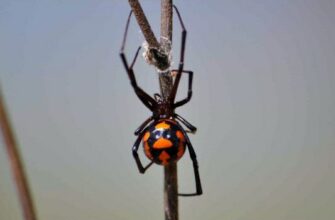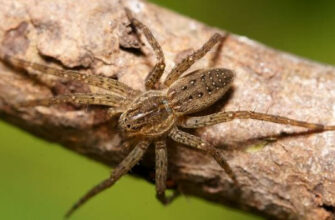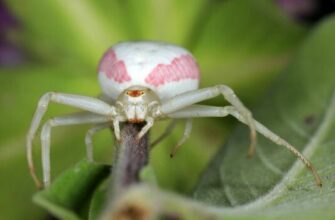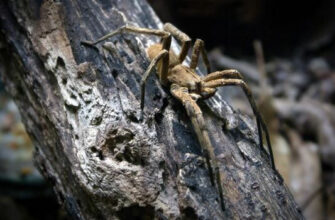The prevalence of sexual cannibalism, in which the female eats the male after mating, has influenced the common name of the species black widow. This species is considered to be one of the most poisonous. The venom of the female spider exceeds the toxicity of poisonous substances in the rattlesnake. However, only the bite of a female is dangerous to humans. The bites of males and adolescent spiders are harmless.
Origin of the species and description
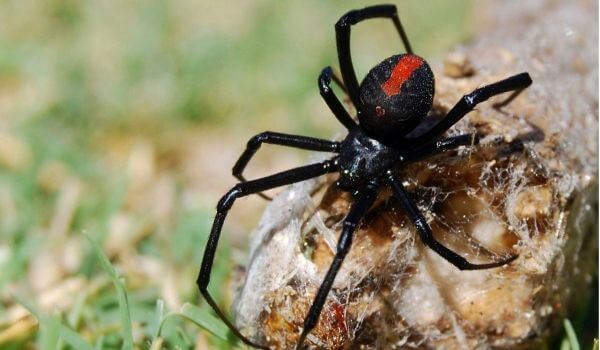
Photo: Black Widow
The black widow genus was classified by Charles Atanas Walkenaer in 1805. Arachnologist Herbert Walter Levi revised the genus in 1959, studying the female reproductive organs and noting their similarities between the described species. He concluded that the color variations were variable across the world and were not sufficient to warrant species status, and reclassified the red and several other species as a subspecies of the black widow spider.
Video: Black widow spider
h3>
Levy also noted that the study of the genus had been extremely controversial until then, since in 1902 F. Pickard-Cambridge and Friedrich Dahl revised the genus, each criticizing the other. Cambridge questioned Dahlem’s division of the species. He considered the deviations that his opponent drew attention to as minor anatomical details.
It is interesting! In the 1600s, the people of southern Europe danced and raved after being bitten by a species of Black Widow. Movement is said to relieve painful symptoms. Their rhythmic movements were later named the tarantella dance, after the Italian region of Taranto.
Many people don’t like spiders. Some believe that they bring bad luck; others, on the contrary, believe that they bring good luck. Black widows have been helpful in controlling pests such as fire ants and termites. In the past, doctors often misdiagnosed after being bitten by a spider. Mistaking the severe condition of the chest and abdomen for the symptoms of a perforated appendix.
Appearance and features
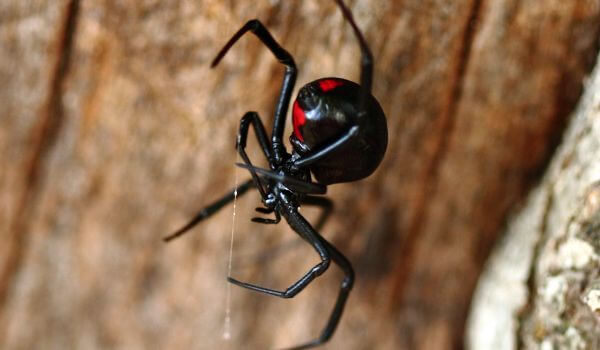
Photo: Black widow spider
The black widow (Latrodectus) is a widespread genus of spiders, a member of the family Theridiidae. The name Latrodectus is believed to mean “secret bite” in Greek. The genus contains 31 species, including the black widows of North America (L. hesperus, L. mactans and L. variolus), the black widow of Europe (L. tredecimguttatus), the Australian red and black widow (L. hasseltii), and the button spiders of South Africa. The species vary greatly in size.
Female widow spiders are usually dark brown or shiny black. Adults have red or orange hourglasses on the ventral surface (underside) of the abdomen. Some species have only a couple of red spots or no markings at all.
Male black widow spiders often have various red, yellow, or white markings on the dorsal surface (upper side) of the abdomen. The females of several species are pale brown and some do not have bright spots. They are larger than males. Spider bodies are 3 to 10 mm in size. Some females can be 13 mm long.
The legs of the widow spider are quite long relative to the body, and resemble a “comb” with a series of curved, elastic bristles on the hind limbs. Throwing webs at prey is done with the back comb.
Note! These small spiders have an unusually strong venom containing the neurotoxin latrotoxin, which causes a state of latrodectism.
Female widow spiders have unusually large venom glands and their bite can be especially harmful to large vertebrates, including humans. Despite their fame, Latrodectus bites are rarely fatal or even cause serious complications.
Where does the black widow spider live?
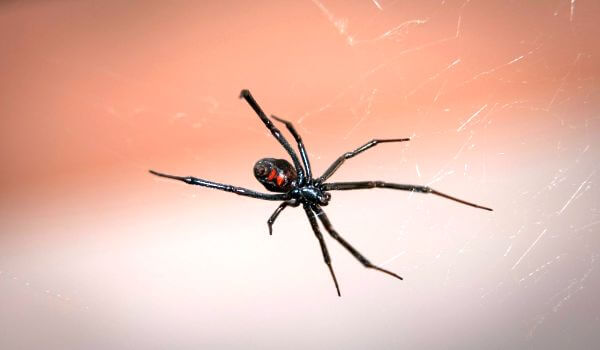
Photo: Black Widow Animal
The species can be found on all continents of the world except Antarctica. In North America, black widows are commonly known as southern (Latrodectus mactans), western (Latrodectus hesperus) and northern (Latrodectus variolus). They can be found in all four deserts of the American Southwest, as well as parts of southern Canada, especially in the Okanagan Valley of British Columbia. In addition, on the American continent there are “gray” or “brown widow spiders” (ometricus) and “red widow spiders” (bishopi).
The area of residence is distributed as follows:
Americas – 13 species;
- Eurasia – 8;
- Africa – 8;
- Australia/Oceania – 3 species;
- One species (geometricus) – lives everywhere except Eurasia;
- The most common species found in East Asia and Australia is commonly referred to as the redback (Latrodectus hasselti). Hundreds of Australians are bitten each year by the red spider, a relative of the black widow. It is found in all parts of Australia except the hottest deserts and coldest mountains.
Interesting fact! Black widows prefer to nest near the ground in dark and undisturbed areas, usually in small holes created by animals, around building openings, or wood piles on the underside of ledges, rocks, plants, and debris. Only cold weather or drought can drive these spiders into buildings.
The brown widow spider (Latrodectus geometryus) is not as dangerous as the black spiders. When bitten, it releases less venom. However, it is a venomous creature and should be handled with care. Found throughout the tropical regions of the world and was introduced to southern Texas, central and southern Florida, and now also found in southern California.
What does the black widow spider eat?
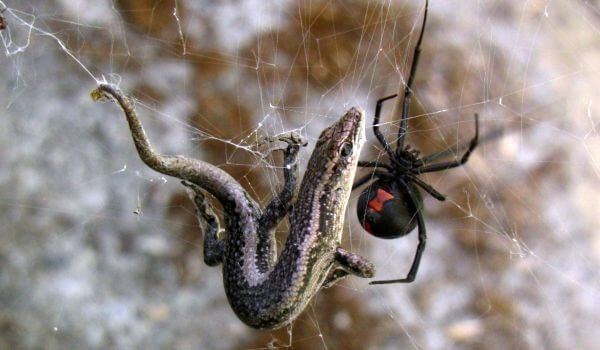
Photo: Poison Black Widow
Like most arachnids, the black widow preys on insects. Sometimes she eats mice, lizards and snakes caught in the net, but very rarely. In the deserts, black widows live on a diet of scorpions. It is known that its web is the strongest compared to other types of spiders. Widows don’t weave pretty webs, instead they create an elastic weave of thick threads, rough and sticky.
A curious fact! The tensile strength of Black Widow’s web has been found to be comparable to that of steel wire of the same thickness. However, since the density of steel is about six times that of the web, the resulting web is stronger than steel wire of the same weight.
To catch their prey, black widows create a “tangle” of three levels:
- Supporting threads on top;
- Tangled weaves of threads in the middle;
- Attached to the ground vertical strands of trap at the bottom with sticky drops.
The spider often hangs upside down near the center of its web and waits for insects to make a mistake and get caught in the web. Then, before the victim can escape, the widow rushes towards her to poison her by injecting poison and wrap her in silk. Her mouth pulses with digestive juices over the prey, which gradually liquefies. The black widow then makes small punctures in the victim’s body and sucks on the supstance, allowing it to be sucked back into the mouth.
The prey caught in the net includes various small insects:
- cockroaches ;
- bugs;
- flies;
- mosquitoes;
- grasshoppers;
- caterpillars;
- moths;
- other spiders.
Like all spiders, black widows have very poor eyesight and depend on the vibrations in the web grid to find prey or danger.
Character and Lifestyle Features
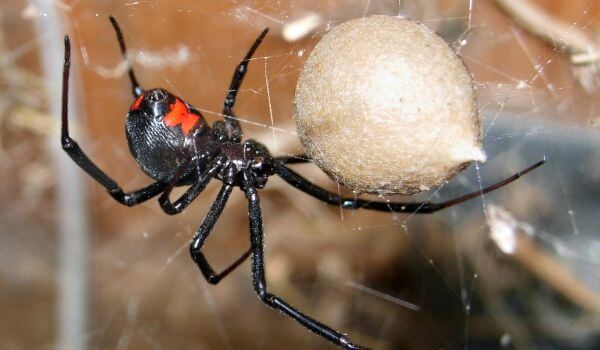
Photo: Black Widow
The black widow spider is nocturnal. She hides in dark and untouched places, in small recesses created by animals, under fallen branches, piles of trees and rocks. Sometimes they live in rodent burrows and hollow tree stumps. Other habitats include garages, outbuildings, sheds. Nests inside dwellings are found in dark, untouched places such as tables, furniture, basement.
Sexual cannibalism in the female actually increases the chances of offspring surviving. However, females of some species rarely display this behaviour. Most of the documented evidence of sexual cannibalism comes from laboratory cages where males cannot escape.
That’s interesting! Male black widow spiders choose their mates by determining whether the female is full at the moment in order to avoid being eaten. They can tell if a spider has eaten by looking at the sensitive chemicals in the web.
The widow is not aggressive, but may bite when disturbed. If she is trapped, she is unlikely to bite, preferring to pretend to be dead or hide. Bites are possible when the spider is cornered and unable to escape. Injury to humans is due to defensive bites received when the female is inadvertently pinched or crushed.
Need to know! Black widow venom is poisonous. When the fangs hit the skin, they stay there for a few seconds. The venom glands contract to deliver the venom through ducts in the fangs.
The syndrome resulting from the bite is known as “latrodectism”. Painful symptoms are felt all over the body. Black widow venom has been called “neurotoxic” because it acts on the nerves. When the nerve endings do not work: the muscles cease to obey, the body becomes rigid, paralysis and convulsions intensify. Sometimes the respiratory muscles stop working, causing suffocation.
Social Structure and Reproduction
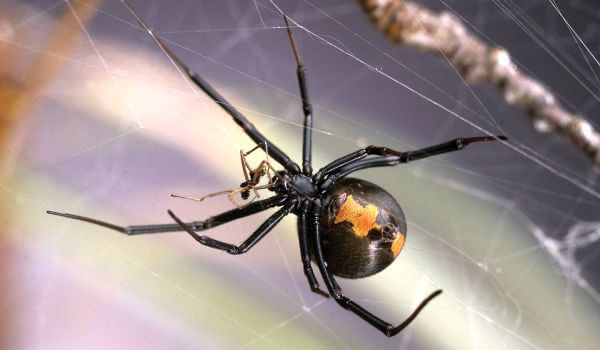
Photo: Black Widow
Black widows usually mate in spring and summer. The female produces an egg mass containing about 200+ eggs. She covers the eggs with cobwebs, then forms a bag out of this, which should protect the eggs from external influences. The bag is hung on a web to keep it away from predators.
It takes about two weeks for the eggs to hatch. Very few young spiders survive because they eat each other as soon as they are born. Spiderlings molt several times before reaching maturity. Diet and temperature are factors that affect the development of offspring.
Remember! Females take 2 to 4 months to mature and have a lifespan of about 1.1/2 years. Males mature in 2-4 months and live for about 4 months. They lose their outer covering (exoskeleton) as they grow.
Sexual contacts between mating spiders last longer if the male allows himself to be cannibalized. By sacrificing his life, he can fill his partner with more sperm. The female holds this sperm in two storage organs and can control when she uses these stored cells to fertilize her eggs.
If she has sexual contact again, the sperm of the second male may displace the sperm of the first. But females that eat their first mate are more likely to reject the next one.
Natural enemies of the black widow spider
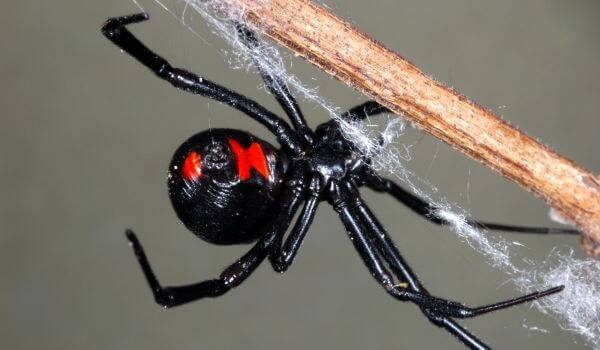
Photo: Animal black widow
These spiders, although a little scary, also have enemies. Several types of wasps can sting and paralyze a spider before being eaten. The black widow is also the mantis’ favorite food. Some birds may eat these spiders and end up with an upset stomach.
Bright red or orange markings in the abdomen warn predators that this is a disgusting meal. Most vertebrates that hunt visually pick up this red and black signal and avoid using it.
Among spiders, brown widows usually replace blacks fairly quickly in their habitats, although it is not known for sure if this is a sign of predation, perhaps they simply drive them away in some other way. Some varieties of cellar spiders also enthusiastically feed on black widows.
Other arthropods can eat black widows, but must be able to grab a spider before it bites them, which they rarely do.
This is a very fast spider, it is able to detect small vibrations produced by a predator in advance. If he is in danger, he descends to the ground along the web and hides in a safe place. The spider often pretends to be dead to deceive a potential enemy.
The blue mud wasp (Chalybion californicum) of the western United States is the black widow’s main predator. Alligator lizards can also sometimes “eat” such extravagant food.
Population and species status
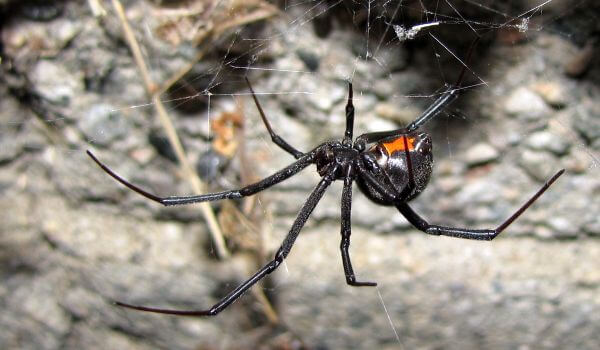
Photo: Poisonous Black Widow
The population of the black widow at the moment is not threatened by anything, and even vice versa. New research shows that over time, the black widow’s habitat is expanding northward and in other directions beyond its normal habitat.
Climatic factors are responsible for changing the habitat of this dangerous insect. For black widows, the most important predictor of their distribution range is the average temperature of the warmest three months of the year. These updated sightings mean health officials in areas not used to seeing the black widow should be prepared for it.
The bite of a black widow can be distinguished by two punctures in the skin. The venom causes pain in the area of the bite, which then spreads to the chest, abdomen, and entire body. The Centers for Disease Control and Prevention says black widow bites are not usually life-threatening for adults, but they can cause severe pain and painful muscle contractions. People bitten by a black widow are advised to seek professional medical attention.
Insecticides are used to control spiders in their habitats when an infestation is detected. Repeat the treatment is carried out at the interval indicated on the label. To further discourage spider entry into your home, you can use an insecticide barrier spray around the base of the home and possible entry points such as door sills, windows, and foundation vents.
According to the researchers, very it is likely that the black widow spider is also present closer to the north. The next step is to conduct further sampling efforts in the habitats associated with these spiders.

